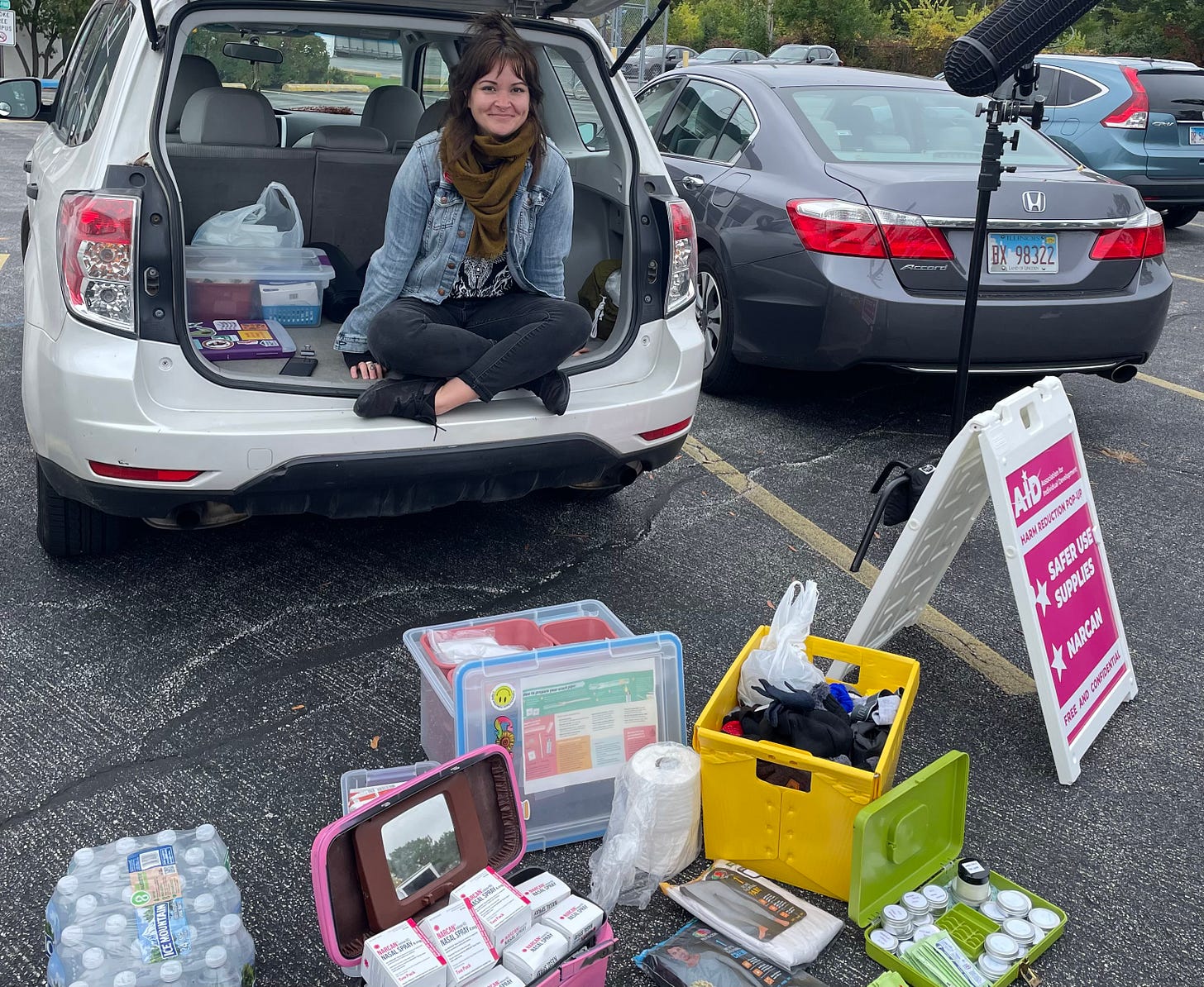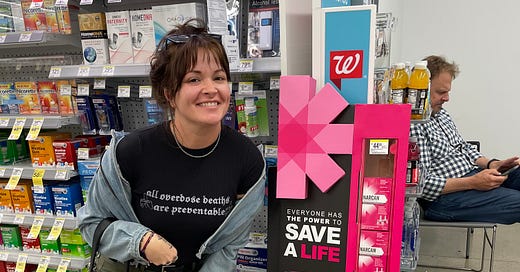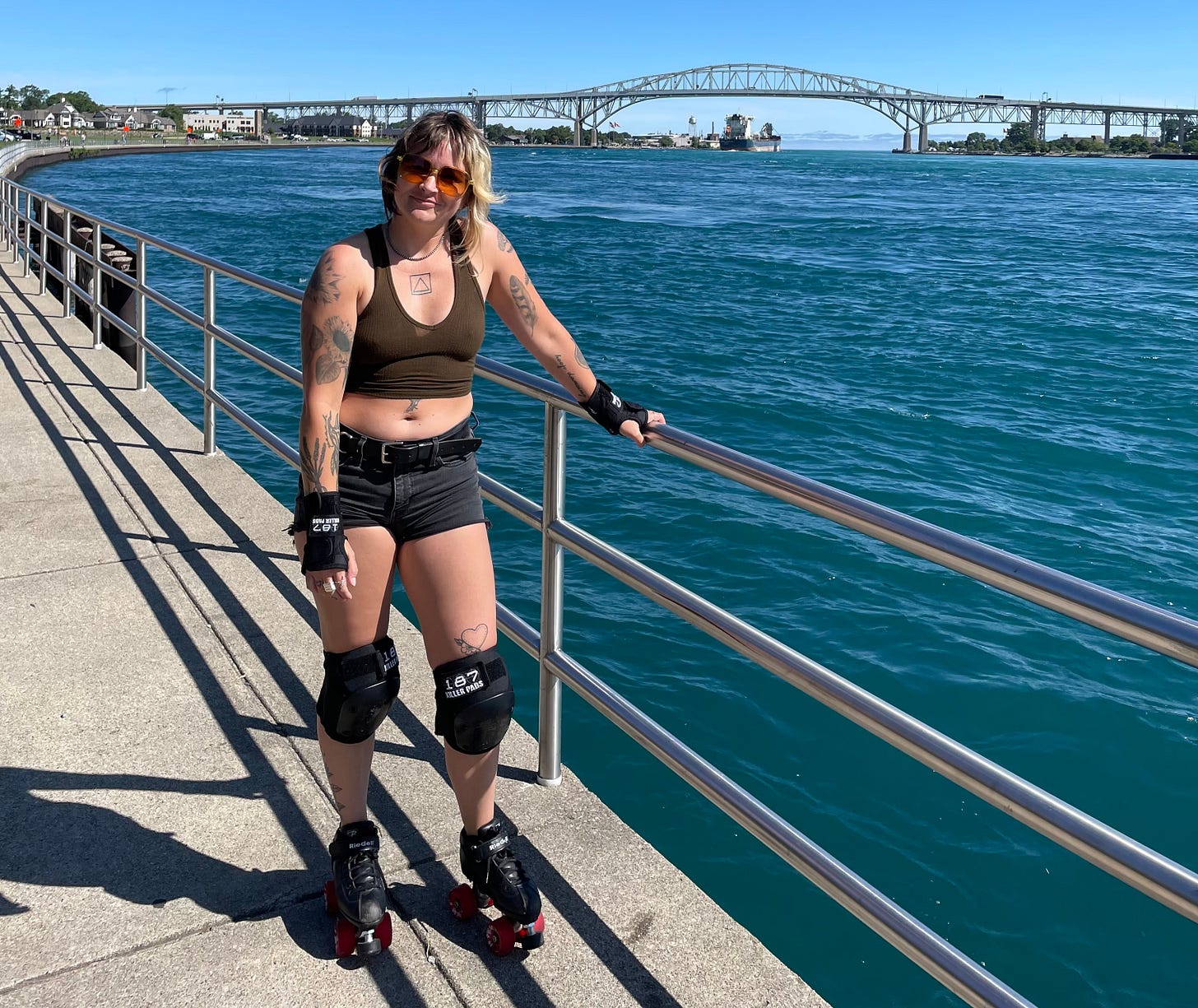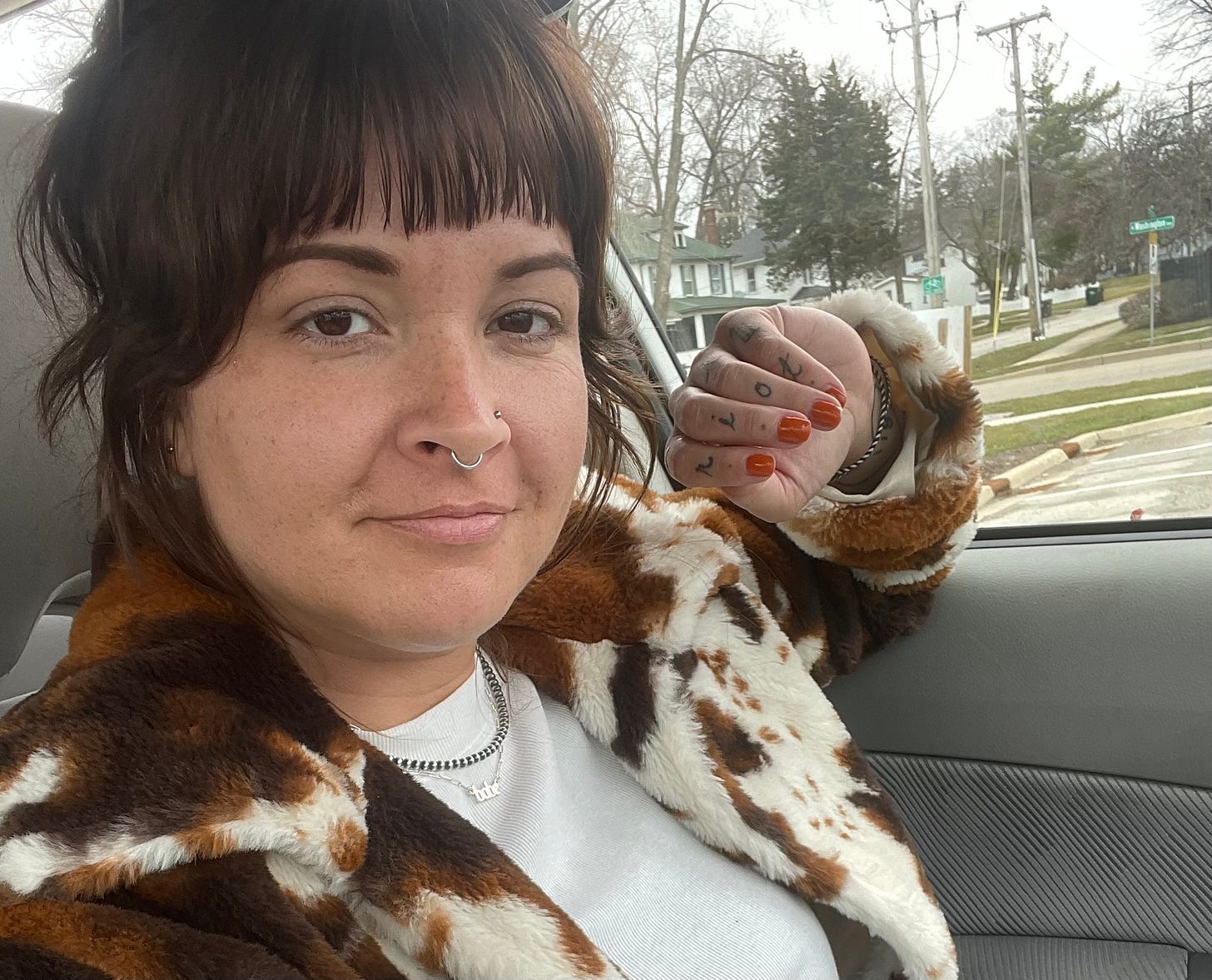the inherent queerness of harm reduction—and why we need it now.
I spoke with Lyndsay Hartman about how her queer identity fuels her work on behalf of communities on the margins.

Queering the Burbs is a regularly-published distillation of pop culture, politics and queerness written by Joe Erbentraut. If you like what you see, please consider subscribing (it’s free!), liking or sharing this piece.
I vividly remember the first time I heard Lyndsay Hartman (she/they) speak. It was via a February 2020 YouTube livestream of a Batavia City Council debate on whether the city would, hypothetically, agree to a cannabis dispensary opening up within city limits in the future.
The discussion was infuriating, as members of the public and members of the council alike fell back on thinly veiled, deeply problematic, and painfully outdated Reefer Madness-style stereotypes in arguing against the idea of a “pot shop” putting down roots in their town. In public comments before the council, a priest pleaded that the council “keep Batavia good for the children,” a community member bemoaned “crazy ideas” around cannabis legalization coming from former Chicago residents who had moved to town, and multiple speakers—including our mayor—referred to cannabis as a “gateway drug.”
Despite the fact that a pro-cannabis referendum was later overwhelmingly approved by Batavia voters and the council has since OKed a cannabis dispensary zoning plan, that night Hartman was one of the few speakers addressing the council with facts and reason. I was so impressed with the way that Hartman countered the false narratives other speakers had presented around drug use, drawing from her own experience running the innovative and effective Point to Point mobile needle exchange program. I was inspired at Hartman’s ability to speak truth to power even when so many powerful forces in the room with them that day stood diametrically opposed to their every word. I hoped I’d one day meet her, I hoped to soak up even just a little bit of Hartman’s bravery and fire.
Four years later, I’m proud to call Hartman a friend and I’ve proudly watched as they’ve continued to serve the community in ways that have evolved past the Point to Point program (which was formally dissolved last year) but have continued to spread an ethos of harm reduction and compassion for individuals seemingly everyone else has given up on. Through her work as manager of the Aurora-based nonprofit Association for Individual Development’s street outreach program, she truly lends a voice to the voiceless. They’re seemingly unstoppable, and if you need further evidence of Hartman’s drive, you only need to watch her kicking ass and taking names as her alter ego “Babe with the Power” during a bout with the Aurora 88s roller derby team.
So how exactly does Hartman do it? As Hartman tells it, their queerness is one of their biggest assets in helping them make a difference for the individuals they advocate for on a daily basis. I recently spoke with Hartman to learn more about her work and her perspective on queerness and community. Our interview has been edited for length and clarity.
How did you first get involved with all the work you do today? Was it something you always felt drawn to or was there a particular impetus?
I usually attribute my story to Brian. I had known him my whole life and we were always very good friends. His story was just really hard and it’s his story to tell. But the part of it that I was involved in was that we were dating and living together and he was actively using heroin. I didn’t know that it was still going on, and there was an overdose. He survived and is still alive and is doing very well, but it really threw me into this world where I had no idea what was going on. I felt so scared all the time and I didn’t know what to do. It set the stage for realizing that there’s a need for services.
A friend who I had met when I was living in the city was a harm reductionist and was posting all of these things on social media and I just kind of inquired about what she was doing. She was the one who taught me the words “harm reduction.” It lined up with so much of how I was already living my life and my activism and my ideas of care and compassion. Time passed and Brian and I separated, which was incredibly difficult. How I mended myself and healed from it was creating this program [Point to Point] and trying to assist other people because I felt like I had this weird set of skills from dealing with Brian where I was really good at connecting people and making things happen.
I learned about harm reduction, I learned about Chicago Recovery Alliance, and I learned that there wasn’t anything out here, and I just threw myself into it. I went to any kind of talk or training I could find and I was meeting people. I went down to the Chicago Recovery Alliance warehouse and they filled my CRV with as many syringes as they could give me before I even knew what I was doing. I followed the lead of others and I knew our community needed this. I knew it firsthand. Creating Point to Point was how I healed and how I put myself back together after the whiplash of being with someone who was very chaotic and in and out of jail and who almost died and stole my money and everything. It was awful, but it was not for nothing. I was going to make something.
Point to Point, then, was really something so deeply personal for you, but you’ve since transitioned out of that into your current role. How did that evolution come to be and how is it going?
Point to Point was always community-funded and just run by me. I saw this position posted for a street outreach case manager with Association for Individual Development and I knew a lot about them because they do a lot of work with folks with developmental disabilities, and most of my beginnings with social services were in that world. So much of Point to Point was outreach. It was going to the soup kitchens and showing up at places.
I got the job there and as soon as I came on they were basically just calling street outreach a case manager who outreached outside. I said, well, if you’re really going to be doing street outreach, you also need to incorporate harm reduction services. They immediately were like, yeah, you’re right. So I started taking supplies out of my living room to AID and was just using what I already had to do the work. Eventually, I was like, you guys should really just take all of this.
That was the moment when I knew it was the time [to let go]. I was crazy burnt out. I didn’t have any boundaries and I was never not working. If someone called me in the middle of the night, there was not one saying, hey, that’s not a good idea. All of a sudden I had structure and support. I had someone else to pay the bills, and I had boundaries. It has absolutely been the best choice.
I don’t want to be the only person in the county doing this. I would like the work to be able to stand on its own without me because, eventually, as much as it is exhilarating at first, it becomes a burden where you’re like, can someone else cover this?
Shifting gears a bit, let’s talk queerness. When did you first know that you were queer or different? What was that journey like for you?
My mom always tells the story about how in first grade everybody wanted the princess dress and the heels and the crown, and I wanted cowboy boots and a cowboy hat. I think that’s the first story of something going on there. But I have always felt otherness, always. I did not fit. I had a very hard time in public school. I was always in trouble for talking or the attitude or whatever it was, and I didn’t understand because other people were talking too. But my voice was stronger, my voice was louder, and the things I was saying I would say with conviction. I’m intense. And again, I was always friends with all the boys.
I had the label of being a tomboy, but it was very hard and conflicting because my home environment was so supportive. There was no idea of what a little girl was supposed to be in my house. Then when I was at school it was like, why are you telling me I’m doing this wrong? I just never felt like I fit. I almost dropped out in high school and ended up getting them to let me out a semester early because I was miserable and my anxiety was terrible.
The otherness has always been there. And then with my queerness, I wasn’t a lesbian, but I wasn’t straight, and so I was like.. what is happening? I started making out with my friends in eighth grade as a party trick because boys liked it when girls kissed. But being bisexual is [seen as] illegitimate in so many ways. That’s how it has always felt. I just thought I was straight, but kissing girls. That’s something, right? It didn’t even dawn on me that I was queer until I was older, when I started to have language for it. But finally learning and understanding and knowing queerness, it feels like home. It’s just like, OK, it all does make sense. It is all me and all of these different sides and feelings that encompass everything.
How do you feel queerness enters into and informs or drives your work?
So much of queerness is knowing how to take care of each other. And that is what I really have maintained. Even leaving Point to Point and moving into working under a large nonprofit, I have maintained that I want my team to be in community with the people that we are serving. We are not saviors. We are not charity. We are in community. And that is what it means to be queer.
Harm reduction has queer roots and was a space where I was like, oh, I do fit here. I fit here because it was folks that were like me and thought like me and felt like me, and it felt good. And so when I do my work, there's no space for judgment at all. I work with folks that have done terrible things and I have to love them anyway. I think that my brain operates from a place of compassion and of abolition and of harm reduction. It’s all queer. That is the framework of how I do this job.
I can't stress enough that there's no space for judgment or shame [in this work]. Queer people know about shame. So, I know that you are not feeling very good about yourself right now because of what your life situation is and how you look and how you smell, and what's going on. And that's OK. I'm still in this space with you, and there's nothing in me that's going to be like, oh, you shouldn't be doing this, or you should be doing that. I think that [framework] has just created such an expansiveness in me that it gives space for loving folks regardless.
Queerness offers this counter to the status quo, and in a lot of ways, being homeless is the same way. You’re living in a world that is not very status quo. I am more comfortable with folks living in their tents and being in encampments than I am in a board meeting. I go to encampments every day and I’m fine because, again, it’s the otherness I feel comfortable in because I’m queer.
What do you see as the biggest misconception with the work that you do?
Right now, I do harm reduction work but I’m also working full-time with folks who are homeless. I work with both populations and they overlap a lot, but there are very standard responses that I have to this question. There’s no access to housing in this area. Affordable housing is non-existent. No matter how hard someone tries, they’re not likely going to be able to get off the street, and I can’t get them off the street. I’ve had a few successes with loopholes, and it is either because something happened that shouldn’t have happened, or someone got pulled off a list but they had been on that list for a year and a half.
A lot of people don’t even think about the barriers and how difficult it is to be homeless and then to not be homeless, and the amount of time it would take to find a place to live and how hard it is. You can’t save money because you’re just trying to survive. And their character is also always called into question. I cannot speak enough about childhood trauma and prison trauma and institutionalization trauma. So many of my folks are in the spaces that they’re in because of trauma. If I had one tenth of the experiences they’ve had, I wouldn’t be where I am. I wouldn’t be able to even get out of bed. They’re the strongest people I’ve ever met. It’s a resilience that I cannot even comprehend sometimes.
At the end of the day, what I tell people is that if someone’s homeless or a drug user or whatever it is, if we take a different approach and actually support and love on people, that’s when we will actually start seeing their growth. That’s why harm reduction works. They know someone gives a shit about them because their whole life they’ve been hiding whatever it is they’re doing. There’s a lot of misconceptions in everything that I am deeply passionate about, and that can be stressful. But some arguments are just not worth having anymore.
In light of that stress and the number of hard days you have in this line of work, what motivates you to keep pushing on vs., say, getting some cozy office job?
I was made to do this. I know that sounds really conceited, and I don’t mean it that way, but I don’t know what else I would do. Some days I wonder what it feels like to have a job with problems you can solve. I’m dealing with homelessness and overdoses. I can’t solve these problems and I hate that, but it keeps me creative. So, on hard days, I remember my success stories and there are three particular ones that I hold really tight in my heart. I’m still in communication with all of them.
It’s also my passion. I love working with people that other people don’t want to work with, that need the extra love because no one else is going to give it to them. That’s been in me for a long time. Sometimes it just feels like treading water. A lot of my clients end up dead or in jail, and I think that’s what society wants in a lot of ways—for homeless people or for people who use drugs to just end up dead or in jail. So, I have to take the small victories, because there are moments of joy and there are moments of complete sacred intimacy that are so special. I know I’m doing what I’m supposed to be doing.
From your vantage point, what do you think the western suburbs could most urgently be doing better on in terms of supporting queer people?
Affordable housing is the first place my brain went to. We do not live in an area that’s super accessible to folks that don’t have a shitload of money. I think a lot of it still feels very performative to me. We can whip out our rainbow flags in June, but are people who are “others” safe in these spaces? I see such a different world. I walk through Kane County in a totally different space than most people. So, for me, I see all the disconnects of access to resources and a lack of funding for things that all connect with queerness in my mind. I think that’s what needs to change.
For more words from queer folks out here doing the work in the western ‘burbs and beyond, read my previous interviews with Batavia artist Annie Hex, Aurora organizer Javi, the organizers of Geneva Pride, Batavia alderman Dan Chanzit, Paramount Theatre artistic director Jim Corti, Aurora trans activist Penelope Torres, North Aurora musician Katie Bogle, Hoof & Horn co-owners Jarrod Johnson and Adrian Xavier Frost, Batavia activist Scott Naylor, Youth Outlook’s Carolyn Wahlskog, and Ramshackle Farm’s Shannon and Eve Mingalone. As always, your support—via comments, shares and subscriptions—is so deeply appreciated.
Programming Note: We are so back, hi! I have missed writing these columns, but my full-time job got a bit busier in recent weeks so this newsletter had to take a backseat for a beat. Hello, in particular, to my new subscribers. I hope you’ll enjoy these missives and please let me know what you think in the comments below.
Also, thank goddess for Annie Clark, because her new album truly fucks. One of my favorite tracks from it is shared below, for your brooding pleasure.
LINK DUMP
BBC: Chappell Roan is the freaky, fun pop star you need to know
The Cut: Where Normani Has Been
New York Times: Honeybees Invaded My House, and No One Would Help
The Atlantic: Crying Myself to Sleep on the Biggest Cruise Ship Ever
Thrillist: Nothing Could Prepare Me for the Bizarre ‘Live Birth’ Experience at Babyland Hospital






